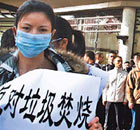Opinion
How to reform our mode of growth
By Gao Shangquan (China Daily)
Updated: 2010-01-18 07:54
 |
Large Medium Small |
China's substantial economic growth model has resulted in the increasing contradiction between China's economic and social development and the pressures to support its population, resources and ecological environment. Six decades since the founding of New China, China's gross domestic product has increased by 14 times, while consumption of mineral resources has multiplied by 40 times. China's consumption of steel products accounted for about 27 percent of the world's total, while cement was more than 40 percent.
This growth model is unsustainable in the future. The impact of the international financial crisis on China is an alarm for the nation's unreasonable growth trend.
Institutionally speaking, the market can't fulfill its role, partly because of inexperienced markets in land, energy and capital, as well as the excessive interference of administrative decrees.
Land resources are mostly in the hands of governments at various levels, and the sale of land rights to external investment has become a major source of local revenues.
Usually, a local government is assigned as much land as possible regardless of what the government may shape up to be in the future. The result is that in China, with fairly scarce land resources, a large amount of land are not utilized fully and are seriously wasted.
Economic activities are directly subject to frequent government intervention and Chinese enterprises still lack the right to invest independently. The decision-making process of how the government invests has not been standardized and policymakers are not responsible for consequences of their decisions.
In order to pursue more political achievements, many officials are busy inviting investments indiscriminately, even at the expense of polluting the environment.
Nonetheless, education, health care and agriculture need more government attention and are not receiving enough funds. The current fiscal and taxation system does not encourage growth in these areas. Considering the existing tax division system, production expansion and employment growth, some local governments may tolerate or even encourage projects that pollute the local environment.
So it is advisable to make the transformation of the nation's growth model as the main line of reform. We must start from institutional innovations and focus on advancing reforms in the following four areas.
First, through market reforms, value-formation measures reflecting degrees of scarcity of resources as well as fair competition must be built. We should continue to speed up the maturation of productive factors and integrate the basic role of the market in the allocation of resources.
The most effective way to curb expansionary demand is changing the price-fixing system of resources, leaving the market to decide prices. We should also improve the fiscal and tax policy that aids any changes to the growth model and use the policy to control the supply and demand of resources.
We should reform how the government invests to eliminate its impulses in expanding investment. We should also call on the government to supply more public services.
Third, speed up economic system reform and call on the government to switch from an almighty and regulatory government to a service-oriented one under the rule of law.
Improving the livelihood of all people is the ultimate goal of our political reform and economic development. We should reform the income distribution system, make the consumption of residents more efficient - especially that of low-income groups - and making spending the driving force for economic growth. Through implementing the urban-rural integration, we should promote urbanization and further open rural areas.
Fourth, we should quicken comprehensive reform by adapting to a low-carbon development. A low-carbon economy is the best choice for China's economic development and is an important road for its economic and growth-model restructuring. As a responsible power, China has proclaimed an ambitious emissions reduction target, which in turn brought challenges for its development. China should turn the pressure into a driving force for further reforms.
The author is honorary president of China Society of Economic Reform.













